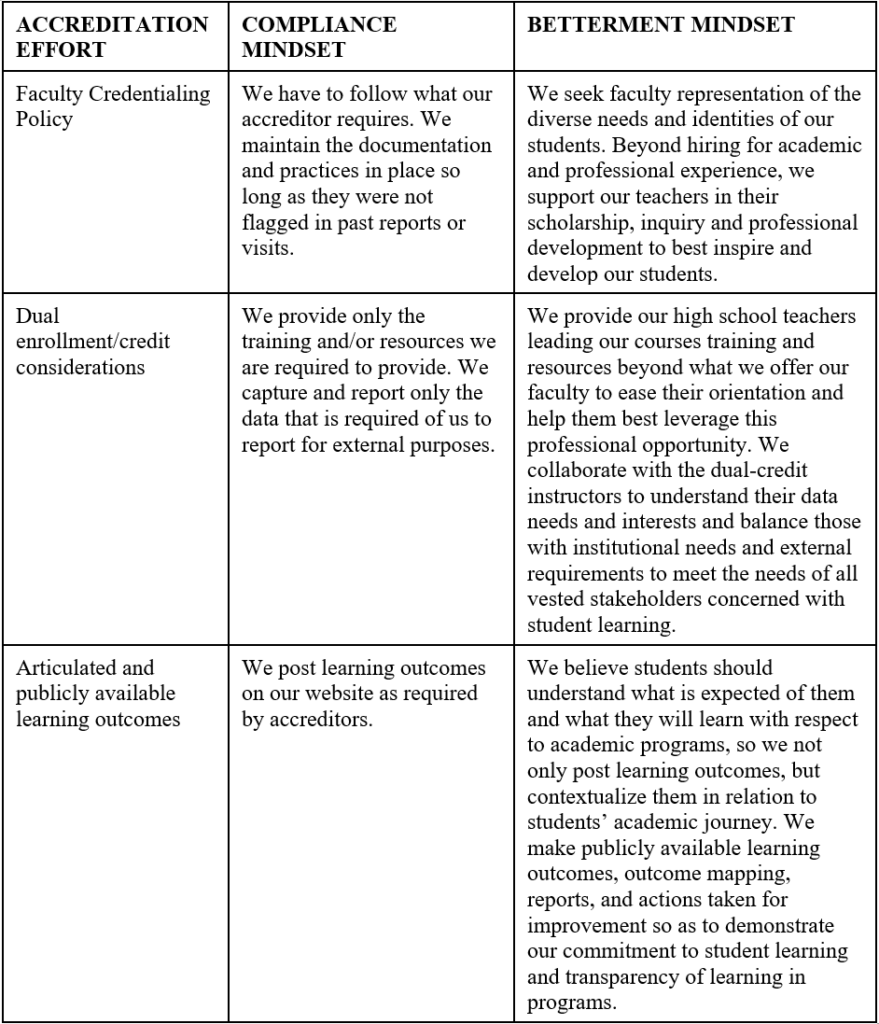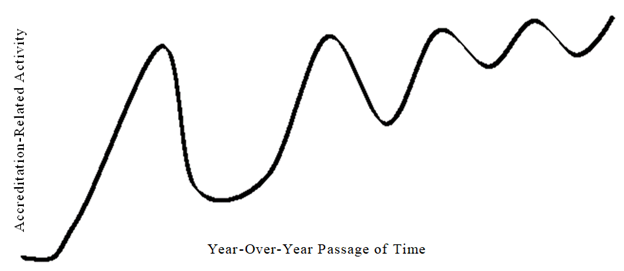While accreditation work consists of adherence to standards and criteria, too often efforts are reduced to simply a compliance mindset to satisfy accreditors (Ewell, 2009; Gaston, 2018; Levy et al., 2018). To combat a compliance mindset with accreditation work, this article encourages a betterment approach to promote continuous improvement rather than focusing solely on meeting external criteria. Mindsets for compliance and betterment will be exemplified and discussed in relation to accreditation activity on campus. Four considerations will be presented as guidance for institutional leaders to promote a betterment mindset. Finally, campus-specific examples will be provided to illustrate one institution’s incorporation of these four considerations in accreditation efforts to reinforce a culture of continuous improvement and betterment instead of simply compliance.
Accreditation Activity
Accreditation-related activity can operate from either a compliance mindset or a betterment mindset that also fulfills accreditation standards. A compliance mindset is deficit-oriented; actions are motivated to meet external requirements. Operating under a compliance mindset prioritizes the needs of the accreditor instead of the institutional community and its constituents. However, there is great power in changing an institution’s mindset and its approach to accreditation work (Feuer, 2014; Kuh et al., 2015; Levy et al., 2018). Practitioners who implement a betterment approach by revisiting their attitudes, engagement, and strategies towards teaching/learning success prove more positive, hopeful, and innovative as their focus shifts to the mission and values of the institutional community. Further, a betterment culture creates opportunities for reflection to satisfy future-state goals. An example of the differences in mindsets can be seen below.

A compliance-only mindset sets the tone for attention, priority, and engagement in related work over time (Gaston, 2018; Suskie, 2014). When this occurs, the institutional culture of accreditation is solely dependent on rushed data collection and reports. With a compliance mindset, it is typical for institutions to have minor faculty engagement with few assessments informing change until the last minute. Activity is low most of the time and then drastically ramps up prior to mandated reports or site visits. Then, once the reaccreditation is successful, there is almost immediate disengagement and return to the low-level priority or consideration of accreditation work. A visual representation of activity could look like the image below.

Behavior looks different for institutions who go beyond the compliance mindset associated with visits and reports to embrace a mindset of aspiration or betterment (Feuer, 2014; Gaston, 2018; Levy et al., 2018). This allows for a more inclusive and ongoing process that prioritizes the needs of the institutional community and cultivates ongoing conversations, assessments, and analysis. Institutional leaders may then embed accreditors’ feedback into future strategic plans to capitalize on institutional momentum, address gaps and elevate practice. A visual representation of activity with a betterment mindset stands in stark contrast to the previous image representing a compliance mindset.

The key takeaway is to combat a compliance mindset, regardless of how fast change occurs (Ewell, 2009; Feuer, 2014; Levy et al., 2018; Suskie, 2014). The goal is not to force everyone to keep accreditation as their top priority all the time, nor do accreditation professionals anticipate it would be immediate or easy for all institutional constituents to shift their perspective. The goal is to strive for betterment, with incremental improvements taking place over time so that there are less marked peaks and valleys in activity during a given accreditation cycle, less intense scrambling followed by business-as-usual behavior despite new insights and opportunities that emerge for continuous improvement.
Mindset Management
There are several approaches accreditation professionals can take to create a betterment mindset within their institution. Four considerations help professionals shift from compliance to continuous improvement: Centering Students, Gathering Evidence, Maintaining Communication, and Embedding accreditation in pedagogical activities. Individually and collectively, changes in approach based on these considerations can move the needle regarding priorities and actions associated with accreditation work.
Institutional leaders can start by placing students at the center of conversations for continuous improvement, framing institutional actions in relation to student impact, and championing student success as opposed to satisfying regulations and requirements (Ewell, 2009; Gaston, 2018; Kuh et al., 2015; Suskie, 2014). Student-centered framing extends to examining policy and practice, setting goals, and implementing strategies. Leaders can reflect upon the spirit and underlying purpose of their institute’s policies, practices, and systems with students in mind — fighting the urge to simply improve existing practices for operational efficiency. Most effectively, leaders invite students as collaborators to offer feedback and insight on policies and practices pertaining to their educational experience.
Shifting to a betterment mindset necessitates evidence of continuous improvement. Because institutions task departments with annual reports, leaders define or redefine their purpose statements, align operations to measurable objectives, and report on department results pertaining to operational and student success. Making department documentation intentional, purposeful, and focused on improvement positively affects the engagement levels of the faculty and staff involved; people are more likely to engage with efforts related to their needs and purpose as opposed to externally-required tasks (Ryan & Deci, 2000; Levy, 2020). Such reporting across the institution can bring to the surface and connect natural themes, gaps, and opportunities for improvement through interventions and resources, as opposed to insight primarily coming from external accreditation requirements. Having the ability to disaggregate and focus on opportunities for improvement at multiple levels of the institution, leaders set aspirational goals to guide annual strategies for action (Kuh et al., 2015; Suskie, 2014). Incremental improvements across departments contribute to ongoing and sustainable betterment in contrast to the sudden onset and high-peak activity associated with compliance-fueled efforts in an accreditation cycle.
Dedicated institutional leaders can model a betterment approach to accreditation-related work with consistent communication to ensure everyone involved is operating under the same goals. The more communication is transparent and made part of existing institutional values and priorities, the easier it is to increase understanding and encourage collaboration to achieve common goals (Gaston, 2018, Kuh et al., 2015; Suskie, 2014). There are several institutional mechanisms to deliver accreditation-as-betterment messaging: new employee orientation, department meetings with time dedicated to assessment, and professional development workshops. University-wide understanding of the commitment to student success fosters a culture of proactive planning instead of the reactive behavior one often sees when accreditors come calling. Leaders can publicly celebrate efforts of early adopters and accreditation champions, highlighting examples of demonstrating good practices which best serve students and satisfies operational efficacy and regulatory requirements
Complementary to communication and celebration, leadership can embed accreditation and quality assurance considerations in everyday activity (Ewell, 2009; Suskie, 2014). Department leads can make quality assurance and continuous improvement standing agenda topics at meetings. Areas throughout the institution can maintain documentation of activity: minutes from meetings, evidence of data-informed actions, reports of improvements, and success stories. Beyond accreditation-related information, departments can create resources and make them easily accessible in a central repository (i.e., website, SharePoint, Smartsheet, Google, shared drives). Having such documentation can also serve as accreditation-related evidence, as well as culture-sustaining information for onboarding employees when turnover occurs. The combination of socializing and normalizing accreditation considerations with existing practices will advance and sustain collaboration for continuous improvement efforts.
Combatting Compliance
National Louis University (NLU) is a medium-size, private, non-profit, doctoral-granting, urban, and Hispanic-Serving Institution with locations in Illinois and Florida. NLU’s institutional accreditor is the Higher Learning Commission and the University maintains good standing with a host of programmatic accreditors (American Psychological Association [APA], Council for the Accreditation of Educator Preparation [CAEP], Council for Accreditation of Counseling and Related Educational Programs [CACREP], International Accreditation Council for Business Education [IACBE], and American Culinary Federation [ACF]). Select examples of NLU accreditation practices incorporating the betterment mindset include assessment reporting, credit-hour compliance, and maintaining a continuous flow consumer information.
All of NLU’s academic programs complete annual assessment reports. Beyond capturing relevant information in one report versus multiple reports, this approach keeps faculty focused on assessment of student learning as a worthwhile practice on its own, versus required reporting by an external entity. The report becomes evidence of embedded alignment to any external standards, as well as results of student learning. Accreditation-related needs are embedded into the report templates, as a number of academic programs also have industry and programmatic accreditor standards to maintain. The report becomes evidence of embedded alignment to external standards, as well as results of student learning. As key stakeholders, students receive report results, offer feedback for actions, and inform assessment strategy at the programmatic and institutional level. Engagement of students vary by program—course engagement, newsletters, and serving on advisory boards – in addition to the University Assessment Council collaborations with a subcommittee of representatives from NLU’s Student Assembly. Throughout the academic year, college leadership offers consistent communication of a betterment mindset driving the University’s assessment work by promoting intentional planning and reporting, celebrating collaborative efforts with college-wide results presentations, and socializing the notion of continuous improvement for the sake of students rather than focusing on the necessities of standards and criteria.
Looking beyond accreditation standards or criteria, NLU’s adherence to credit-hour compliance is examined through the student perspective. Each course considers the effort a typical student puts forward with direct instruction and non-direct instruction activities associated with a course. Being student-centric in considering course activities helps to ensure the credit amount assigned to the course is appropriate for the load and expectations of time invested by the student. Webforms are filled out by faculty and subject-matter experts to capture course activity information as evidence. NLU embeds credit-hour compliance considerations as part of regular course creation and redevelopment processes. To underscore the importance of consistent and equitable assignment of credit in relation to student load, the accreditation staff have created resources and templates to support flexibility and accommodation of credit-hour compliance information across disciplines, modalities, and course types: standard, internship, lab, student teaching, independent study, thesis/dissertation. The resources and experience-specific guidelines represent continuous improvement steps taken by NLU to help center the focus on appropriateness for students in relation to credit assignment, as opposed to a one-size-fits-all federal definition applied for compliance purposes.
NLU’s accreditation staff expands resources to employ a betterment approach to their consumer information page. Consumer information pages on institutional websites typically consist of information mandated or required to be publicly posted. While accreditation staff want to satisfy requirements, they also want to include relevant and useful information for visitors to the page. Resources and weblinks are organized by topic, including a student-specific section. Accreditation staff work with marketing, college leadership, and other stakeholders to best present information on all of NLU’s subpages so that updates need only happen in one place and all other cross-references steer readers to the most updated source. These actions are especially helpful to students trying to compare or keep track of information while visiting multiple parts of NLU’s website. To maintain management of the website as accreditation-related evidence, the University’s accreditation team collaborates with relevant stakeholders to engage in reviewing and updating the webpage content during the calendar year.
Throughout each of the presented NLU practices, efforts go beyond compliance and promote betterment. Student needs and perspectives are driving factors for each practice. Because each practice is relevant to accreditation, attention is paid to gathering and maintaining quality documentation as evidence. Role modeling and messaging of a betterment mindset are paramount in communication about the purpose of the activity, as well as embedding the work in regular practice to support normalization. Though made specific to NLU, these applications might inspire assessment professionals to apply these continuous improvement considerations to combat a compliance mindset.
Conclusion
Accreditation work is critical for compliance, but operating under a compliance-only mindset narrows the rewards of accreditation efforts. Differences between a compliance and betterment mindset are exemplified through four considerations to move toward a betterment approach. Specific examples of accreditation-related work at National Louis University demonstrate how these considerations are infused as a way to help institutional leaders maintain a compliance mindset while improving the groundwork needed for student success. While institutions cannot avoid efforts associated with standards and criteria requirements, leaders can positively change their culture and approach to accreditation-related work with a focus on betterment and continuous improvement.
Author(s)

Dr. Joseph D. Levy serves as the Executive Director of Assessment and Accreditation at National Louis University in Chicago, IL. Joe earned a BA in English from Baldwin-Wallace College, an MS in Student Affairs in Higher Education from Colorado State University, and his Ed.D. in Higher Education Leadership from National Louis University. Joe is a member of the Student Affairs Assessment Leaders (SAAL) Board of Directors, co-creator and instructor for the Applying and Leading Assessment in Student Affairs open course, and endorsed speaker for the National Institute of Learning Outcomes Assessment (NILOA). Author, presenter, trainer, and consultant, Joe enjoys leveraging his academic and student affairs experience from multiple institutional types to talk assessment, quality assurance, and institutional betterment.

Mital Patel is the Director of Accreditation at National Louis University, managing external regulatory approvals. Mital engages with areas across the institution to author shared policy documents, as well as establish university procedure. She also leads trainings, presentations, and information sessions about accreditation-related topics, visits, and reports. Mital earned a BA in Applied Psychology from University of Illinois, Chicago and a MA in Applied Social Psychology from Ball State University and has worked in higher education for over 10 years. Her optimism and appreciative inquiry mindset provides a great perspective for accreditation possibilities.
References
Ewell, P. (2009, November). Assessment, accountability, and improvement: Revisiting the tension (NILOA Occasional Paper No. 1). Urbana, IL: University of Illinois and Indiana University, National Institute for Learning Outcomes Assessment.
Feuer, L. (2014). Changing the accreditation mindset. Champion Chat, 5(1), 1. Retrieved from http://www.hqaa.org/docs/championchat/20140205vol5qtr1.pdf
Gaston, P. (2018, April). Assessment and accreditation: An imperiled symbiosis. (Occasional Paper No. 33). Urbana, IL: University of Illinois and Indiana University, National Institute for Learning Outcomes Assessment (NILOA).
Kuh, G. D., Ikenberry, S. O., Jankowski, N. A., Cain, T. R., Hutchings, P., & Kinzie, J. (2015). Using evidence of student learning to improve higher education. San Francisco, CA: Jossey-Bass.
Levy, J. D. (2020). Self-Determination Theory and faculty behavior: A quantitative study of faculty leaders’ use of assessment evidence. Dissertations. 434.
Levy, J. D., Hess, R. M., & Thomas, A. S. (2018). Student affairs assessment & accreditation: History, expectations, and implications. The Journal of Student Affairs Inquiry, 3(1). https://drive.google.com/file/d/1uJ2f6DTswtx27RhLn42LK7DKVamH4o9G/view
Ryan, R. M., & Deci, E. L. (2000). Self-determination theory and the facilitation of intrinsic motivation. American Psychologist, 55(1), 68–78.
Suskie, L. (2014). Five dimensions of quality: A common sense guide to accreditation and accountability. San Francisco, CA: Jossey-Bass/Wiley.


The goal is to strive for betterment, with incremental improvements taking place over time so that there are less marked peaks and valleys in activity during a given accreditation cycle
AI-driven password generation algorithms enable hackers to guess passwords through trial and error or exploit data from previous breaches to decipher common password patterns. Additionally, hackers employ AI technology to create fake fingerprint and voice samples to deceive biometric-based systems, allowing them to bypass security measures based on these traits.